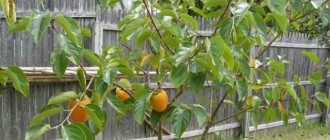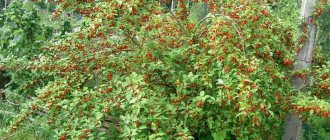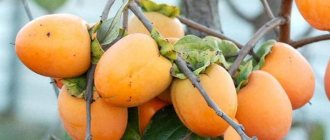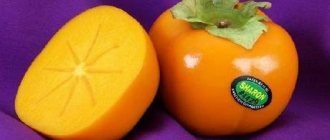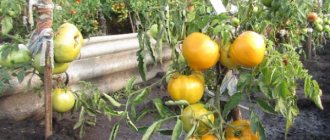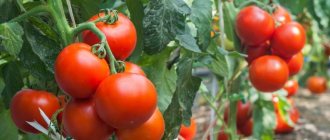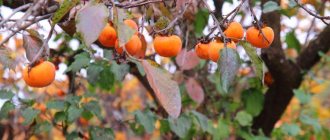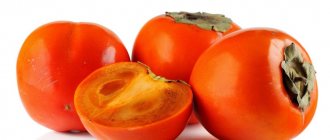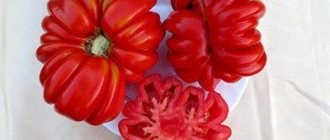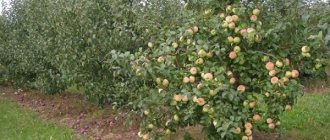Persimmon is a tropical deciduous tree that has become popular due to its sweet, honey-like fruits with a bright orange color. Selection work has made it possible to obtain unpretentious plants that amaze with their productivity.
Attention!
If you plant and care for persimmons correctly , the plant will delight you with a rich harvest and will be less susceptible to diseases.
Where and how persimmon grows: features of the culture and its cultivation
Bright orange fruits, which appear on shelves only in late autumn and winter, cannot be seen in the gardens of the middle zone.
How do persimmons grow? Where is the birthplace of this plant, and what are the features of its cultivation? The usual, native habitat for persimmons is the subtropics and tropical regions of Asia. An extensive genus of deciduous trees belonging to the Ebony family includes more than seven hundred species, which are distributed from China and Transcaucasia to Malaysia.
Where do persimmons grow?
Man has long appreciated the taste of ripe persimmon, and today various varieties of the plant are cultivated all over the world, where climatic conditions allow.
Thanks to selection and the emergence of frost-resistant seedlings, persimmon has significantly expanded its natural range. A culture with a long growing season has found a place in gardens in southern Europe, on the North American continent, in Japan and Australia. Sweet fruits most often come to Russian stores from Turkey, Israel, the countries of Transcaucasia and the North Caucasus, where from time immemorial cultivated trees of a local, rather unpretentious species have been grown.
Since the beginning of the last century, the cultivation of persimmons has been established in Crimea. A plantation of a valuable fruit crop has been established in the Nikitsky Botanical Garden. Serious scientific work was also begun here to develop new winter-hardy varieties adapted for Russian conditions.
Among the achievements of Crimean breeders are the Rossiyanka and Nikitskaya Bordovaya varieties, which successfully bear fruit on the peninsula and withstand cold temperatures down to –25 °C without much loss. These varieties made it possible to grow persimmons in Ukraine.
Planting persimmon seeds
In order for Asian persimmon seeds to start growing, you will need a cleaned planting mixture and a pot measuring approx. 20 cm. A good way to determine the depth to plant the seed is to place it at a depth equal to the diameter of the seed.
Step by step guide:
- Select ripe persimmons in late autumn or early November, or buy them at the vegetable market. When ripe, the fruit becomes soft and takes on a bright orange hue.
- Cut the fruit in half. Remove the dark, raisin-sized seeds and peel them immediately as they have a jelly-like coating that ferments them. Dry them by placing them in a dry paper towel for 48 hours.
- Mix the seeds with a few handfuls of damp peat moss. Store in the refrigerator in a sealed plastic bag for two months. Keep the temperature between 2 and 5 degrees Celsius.
- Select a planting site with light, humus-rich soil and partial sun. Work at a depth of up to 20 cm. Make a small trench using a hoe or the edge of a shovel. Water the trench well.
- Remove the seeds from the refrigerator and soak in cool water for two or three days. Plant them 30 cm apart along the trench at a depth of 4 cm in spring or early autumn.
- Thin the seedlings once in the first fall, leaving every 6th. A year after planting, healthy seedlings should be 20 cm in height. Thin them out again the second fall, leaving only the number of persimmon trees you want to grow. Keep in mind that each mature tree can reach 1-1.5 m in height.
Tools you will need:
- paper towels;
- peat;
- plastic bag;
- shovel or hoe;
- bowl of water.
Shoots and leaves
The shoot is expected to appear one to six weeks after the seeds are planted
It is important to keep the soil moist during seedling growth and development. Keep Asian persimmon seeds in a warm, sunny location during the first growing season.
In the spring, after germination, you can plant a new seedling in the garden. The best planting location is an area in full sun with well-draining, slightly acidic, sandy or loamy soil.
To grow persimmons from seedlings, you need to use bare root seedlings, planting them in cultivated soil in the spring. Persimmons can also be planted in a pot almost all year round, although you should avoid the hottest summer months. Don't be surprised by the black roots - this is their natural color.
Well-drained soil is always preferred, but persimmons, especially Japanese persimmons, are tolerant of a variety of soils.
How to plant
For bare root plants, dig a planting hole that is about the same depth as the roots and twice as wide. Create a cone in the middle of the hole that is deep enough so that the tree's crown sits just above the soil line. Fluff the roots along the sides of the hole to encourage root expansion. Set the tree in place, spreading the roots around the cone, and fill it with soil.
For container-grown plants, dig the planting hole so it is the same depth as the root ball and twice as wide, then flatten the bottom of the hole slightly. Then place the plant in the hole and fluff up the roots. Fill in the soil and create a small irrigation berm around the outside of the hole.
After planting, you can trim off any excess branches to form a crown. Then water well and add mulch at least 7cm from the trunk.
What does a persimmon tree look like, flowers and leaves
The plants that make up the Persimmon genus are fairly large, long-lived trees, which in favorable conditions reach a height of 8 meters and an age of 500 years. Cultivated varieties retain the characteristics of their wild ancestors. The trees have a wide spreading crown with long drooping branches.
A peculiarity of the culture is the presence of male and female plants, externally differing in the shape and nature of the flowers. Therefore, to increase productivity, several pollinators are planted near the plantation with fruit-bearing trees. You can find out how persimmon blooms from the photo. Female, single flowers are distinguished by wide sepals and the shape of a corolla with a diameter of up to 2–3 cm.
Male flowers sit on the shoots in a cluster, sometimes in small inflorescences of 2–5 pieces. They have a narrower, glass-like shape and yellowish-white petals. In different regions, persimmon flowering can begin from March to May.
Simple leaves up to 7 cm long, alternately sitting on the shoots, can be recognized by:
- oval-heart-shaped;
- by light green color, becoming darker as it grows;
- smooth surface with a clearly visible network of veins.
In autumn, the trees turn yellow and red. At the same time, falling leaves have virtually no effect on the appearance of the persimmon tree, because all the branches are covered with orange, yellow and almost red fruits.
Description and useful properties
Everyone probably knows what ripe persimmon fruits look like. After all, with the onset of the season, they appear on every fruit stand. But not everyone has seen the plant called persimmon.
Important! To buy high-quality persimmon fruits in the store, pay attention to the striping of the fruit. The more light stripes on its skin, the sweeter it is. A good berry should be firm and smooth to the touch, and its pulp should be semi-liquid.
Today you can admire small persimmon trees or bushes not only in the homeland of the culture, in China. They grow successfully in the gardens of Australia, Japan, North America and Europe. These plants are considered long-lived because they live for 500 years. In their habitat, they reach eight meters in height and retain clear signs of wild ancestors.
The trees are distinguished by a wide branched crown with weeping shoots, alternating simple leaves, and male and female flowers. Taking into account this feature of the crop, experienced gardeners place specimens of different sexes in the vicinity, which helps to increase productivity.
Fruit plants such as figs, sharafuga, cherry, actinidia, nectarine, pawpaw, bergamot, cashew, kumquat, lemon, almond, medlar, papaya, feijoa, citron, jujube are becoming increasingly popular among gardeners.
Unlike male buds, female buds are characterized by a wide sepal and an elongated corolla. And pollinators have yellow-white petals that are arranged in the shape of a wide glass. Flowering begins in spring and depends on the climatic conditions of the region.
With the onset of autumn, the trees begin to lose leaves, but this process does not at all affect the decorativeness of the crop. After all, the branches are densely decorated with large orange fruits that hang until the cold weather. The color of their peel, depending on the characteristics of the variety, can vary from bright yellow to purple-brown. Very often, Crimean persimmons end up under snow, since their ripening lasts until December .
Did you know? Ancient Chinese sages called persimmon “God's sun” and believed that it should have a tart taste.
The peculiarity of the fruits of this plant is the specific jelly-like pulp in one variety and the hard fibrous interior in another. The last berries acquire a pleasant taste when exposed to frost, but the first ones can be enjoyed even before they are ripe.
drawback of fruits is their tendency to spoil quickly. Hard-skinned specimens are more profitable, because after harvesting they can sit for a month and a half, after which they become even tastier.
According to experts, berries contain a lot of beta-carotene, which helps improve vision and prevents the eye muscles from aging. In addition, the substance takes care of the respiratory tract, cleanses them and prevents the development of various diseases, including seasonal ones.
The fruits contain microelements and organic acids necessary for human health, which strengthen the immune system and have a beneficial effect on the process of blood formation. We are talking about the calcium, potassium, iron, sodium, magnesium, iodine and phosphorus present in the chemical composition of the fruit. In addition, persimmon is rich in retinol, ascorbic acid, thiamine, ryboflavin, and niacin.
Herbalists say that persimmon juices and teas are an excellent remedy for acute respiratory infections, anemia and even diseases of the cardiovascular system. Also, the astringent and bactericidal properties of the fruit have a good effect on disorders of the gastrointestinal tract.
Important! To remove excess astringency from persimmons, place the fruits in the freezer overnight. In the morning, the berry will acquire a soft, delicious taste.
3 berries a day are enough to cleanse the kidneys of accumulated salts. This effect is possible thanks to the magnesium it contains, which promotes filtration of the genitourinary system.
The berries are also successfully used as an antiseptic for healing wounds and burns. Pieces of them are used to wipe the face with problem skin, acne or large pores. Moreover, the fruit has a calming effect on the nervous system, which ensures sound sleep and excellent mood.
Features of persimmon fruits
For those interested in how persimmons grow, it will be useful to know a little information about its fruits. In place of the female flowers, at the end of flowering, a green dense ovary is formed, inside which there can be up to 10 large elongated seeds. As the fruits ripen, they acquire an oval, pointed or rounded heart-shaped shape. There are varieties with flattened berries.
Depending on the variety and type, the color of ripe persimmon also changes, ranging from light yellow to almost brown. Ripening begins in September and continues until December, so when persimmons are grown in the Crimea, North Ossetia and Ukraine, they sometimes end up under snow.
Most often, Oriental, Caucasian and American persimmons are grown in gardens. Varieties with sweet, non-astringent fruits are especially popular among gardeners and consumers.
Anyone who loves the sweet taste of persimmons knows that the fruits are divided into two categories.
- The first ones are tasty even if they are not too ripe. They have soft flesh without pronounced fibers, which becomes jelly-like in ripe fruits.
- In the second category of persimmon, the fruits become edible only after falling under the first frost or artificial freezing. The pulp of these varieties is coarser and contains more fiber.
Both varieties have their pros and cons. Persimmons with soft, delicious fruits do not tolerate long-term storage and transportation. The slightest damage to the skin threatens rapid spoilage. Hard, astringent fruits can be stored for up to 30–40 days, and then after exposure to sub-zero temperatures, enjoy a healthy delicacy.
How is it grown?
The homeland of persimmon is the warm countries of Asia. Nevertheless, this fruit can be grown even in the harsh climate of Russia, since breeders have long developed frost-resistant varieties.
Persimmon grows on a low tree with spreading branches, from which you can harvest up to 80 kg of harvest. But the fruits will be small. To plant persimmons, choose a well-lit place and an area of 25 to 80 square meters. m.
The seedling can also be grown at home. To do this, take a seed from a ripe fruit and dry it at room temperature. Next, it is soaked for 30 minutes in a special manganese solution to disinfect it. The seed is placed in the refrigerator for 2 months and taken out only after the sprouts awaken. Afterwards, the prepared seed is again soaked in a solution that stimulates the development of the plant for several days.
To prepare the soil, use a mixture of black soil, peat, expanded clay, wood ash, sand, and sawdust. The bone is placed in a pot in a horizontal position. The ground is watered and covered with glass, creating greenhouse conditions. The first shoots will appear within 1 month. When the plant reaches 1.5 m in height, it is transplanted into open ground.
It is best to plant persimmon seedlings in the spring. In the summer, the plant will be able to adapt and prepare for winter.
For planting, dig a hole 30 cm deep. Drainage with sand is placed in it and sprinkled with black soil with the addition of manure. If the plant is going to be planted in the fall, then it is best to choose September and catch it before the first frost. Fruits appear on the tree after 3 years, provided that all the rules for planting this plant are followed.
In Russia, they grow an early variety (full ripening occurs in September - October), mid-season (October - November) and late (December). When frost occurs, it is necessary to remove all the fruits from the tree, even if they are not yet ripe. Fruits can ripen perfectly if you leave them to rest.
There are quite a large number of persimmon varieties, but among all of them we can distinguish “Virginsky”, “Eastern” and “Caucasian” types. Since they have high frost resistance, they are most valued by Russian gardeners.
Persimmon is very resistant to various diseases and fungal infections. However, the tree may develop powdery mildew, which causes a white coating on the leaves. Due to root rot, the leaves turn pale and the roots are completely destroyed. With bacteriosis, the bark is damaged and the tree becomes bare. Fusarium causes the bark to fall off and the trunk to turn black. Scab affects the leaves, forming black spots on them.
In order to protect trees from pests, you can spray them with a 1% solution of Bordeaux mixture. If the plant is not treated in time, the disease can spread to the roots and completely destroy them.
Special preparations are also used to control pests. These include “Bikop”, “Boverin”, “Aktofit” and “Akarin”. You can also buy “Gaupsin”, which acts not on just one pest, but on a number of diseases.
To prevent the appearance of lesions on the tree, you need to properly care for it. Persimmons need constant watering, which is done every 3 months. The best fertilizers for this plant are organic. Additional nutrition in the form of humus is introduced in the spring. Ash is added to the soil before flowering. As mineral fertilizers you can take nitrophoska and Kemira. To add all the nutrients, dig small holes around the crown and water them with water.
Persimmon is a rather unpretentious plant. The main thing is to grow a seedling correctly, or buy a good one at the market and plant it in open ground.
You will learn more about the places where persimmon grows by watching the following video.
How persimmon grows: requirements for open ground
In nature, persimmon grows in warm regions with a long warm period of the year. Modern frost-resistant varieties have made it possible to push back the northern limit of comfortable growth to the southern regions of Russia. How to grow persimmons in your garden?
Observing how persimmon grows in Crimea, on the Black Sea coast of the Caucasus and Ukraine, in northern Ossetia, you can notice that trees in open ground prefer well-lit areas with protection from wind and flooding in the spring and autumn.
The culture is undemanding to the type and composition of the soil, while it can react to excess organic matter by dropping the already formed ovary. The main thing is that the powerful root system receives enough air and moisture.
Read also: What soil for aloe can be used at home?
If persimmons find themselves in arid conditions, the quality of the crop deteriorates; prolonged moisture deficiency causes the ovary and foliage to fall off.
In regions where persimmon grows in natural conditions, the trees bloom already in the warm season, and the fruits have time to fill and practically ripen before serious frosts. To the north, persimmons need protection from freezing and the danger of spring rain. This applies to both fruit-bearing trees and plants grown for decorative purposes.
To prevent harvesting from a tree 6–10 meters high from turning into a risky adventure, the persimmon crown begins to be formed from the first years after planting. In addition to limiting growth, they prune young, too thin branches, which often cannot withstand the weight of the fruit and are the first to freeze in cold winters.
About growing persimmons, figs and other heat-loving crops in Crimea
Persimmons, figs and pomegranates can be grown in open ground, especially since the climate in Crimea has warmed - summers have become dry and hot, and winters are much milder. Now gardeners who are not afraid of experiments have the opportunity to grow subtropical crops in the northern regions.
After many years of experiments with subtropical plants, I developed a method for growing figs, pomegranates, almonds, persimmons and feijoas in open ground, which showed good practical results.
How can you grow these wonderful plants in open ground and ensure that they not only delight the eye with exotic leaves and flowers, but also produce high-quality harvests?
In Russia and Ukraine, subtropical plants are cultivated in the southernmost regions, where there is a lot of sun and warmth, and winters with negative temperatures are very short. In this region, they grow in open ground, without shelter for the winter, and although in some cold years (severe frosts occur once in a while they freeze, they quickly recover. Those who want to grow subtropical crops in the northern regions will have to shelter them for the winter, as grape.
How to grow persimmons yourself?
Becoming the owner of your own fruit-bearing tree on your property is quite simple. To do this, you should purchase a frost-resistant persimmon seedling, plant it and take care of it until bright, ripe fruits appear.
Persimmon can be propagated by growing it from the seed of a ripe fruit. Unfortunately, seedlings do not retain varietal properties, so the plant will need grafting to produce abundant fruiting and produce sweet berries.
The best rootstock is considered to be Caucasian persimmon, which is characterized by increased winter hardiness, undemandingness to soil and endurance. The tree has a powerful fibrous root, thanks to which the plant can easily transfer to a larger pot. In the spring, when the trunk reaches a thickness of 1 cm, a cultivar of any type can be grafted onto a strong seedling. It is convenient to inoculate an additional pollinator on a grown tree.
In most of Russia and the Moscow region, growing persimmons in open ground is problematic. A short summer is not enough for the fruits to set and ripen; during and after flowering there is a high risk of frost, and in winter the frosts are too strong even for resistant Crimean varieties. Therefore, it is better to grow persimmons in pots. In this case, a tree up to one and a half meters high is easy to care for and with good care, even get a good harvest.
Russian Persimmon on a summer cottage - video
Care
Watering
In regions with a dry, hot climate where there is little precipitation, additional watering is carried out. Persimmon is difficult to tolerate overdried and flooded soils; in such conditions, the seedling will quickly die. In hot weather, the tree is watered abundantly 2-3 times a month in the evening.
Watering of seedlings grown from seed at home is carried out more often than for specimens purchased from nurseries.
Trimming and shaping. Decorativeness
To increase productivity and grow a strong, healthy tree, it is important to carry out formative pruning of branches every 1-2 years. First of all, crooked, dry, damaged branches are removed, leaving strong, healthy 4-5 branches on the trunk, which will further form the skeleton of the tree. The next year, the main branches are cut so that their length does not exceed 1.2–1.5 m. Side branches and excess young shoots are cut off with pruning shears. When pruning branches, do not forget about the appearance of the tree and its decorative effect.
Fertilizer
Seedlings and mature trees are fertilized 2-3 times. For the first time in the spring, when young shoots are formed, biofertilizers or a mineral complex are applied for growth. The second time during flowering, phosphorus-potassium fertilizer is applied. The third time in the fall before frost, compost, manure or preparations containing nitrogen.
Peculiarities
The Russian was the result of crossing Virginia and Eastern persimmons.
Its distinctive features include:
- frost resistance (ability to withstand frosts down to -35 degrees);
- bears fruit regardless of the sex of the tree;
- already after 2 years the first harvest is observed;
- the tree does not need to be treated with chemicals during the growth process.
The tree is small or medium-sized, however, it can reach 5-6 meters. Persimmons bloom at the same time as grapes, that is, in early July.
Flowers are only female. The fruits are yellow-orange, small, with a small number of seeds.
They are hard to the touch and have a tart taste. Only after “resting” under certain conditions does the persimmon acquire a soft structure and sweet taste.
It is recommended to grow persimmons in the garden in open ground. Young seedlings (no older than 2 years) are selected for planting.
Older seedlings may not survive transplantation. Before planting, it is necessary to prepare the seedling itself: place its root system in water for several hours.
The planting hole is prepared as follows: a hole is dug with approximate parameters of 60x60x60; filled in equal proportions with sand, soil and fertilizer of your choice. In the next few years, you should not use any fertilizers so that the seedling uses all its strength to accelerate growth.
The planting pit is prepared in a day or two. During this time, it will have time to evenly warm up and ventilate.
After this, the planting process can be carried out. In order to protect the young seedling from the wind, it is recommended to install a high peg to which the persimmon is tied. A more detailed and visual process of planting a persimmon seedling can be seen in the video.
Caring for a Russian woman is not difficult, but there are some peculiarities here too.
Russian persimmon loves loose and slightly acidic soil. Take this into account and loosen the soil around the tree in a timely manner. To acidify the soil, you can use ordinary vinegar diluted in water.
After planting, you need to constantly water the persimmon. It tolerates excess moisture well; without it, young trees can die. Therefore, at the very beginning, do not skimp on water.
The same applies to low temperatures. Although the Russian variety is able to withstand temperatures of -35 degrees, young seedlings aged 2-3 years need protection. Therefore, in winter, carefully close and insulate the persimmon.
Features of seasonal care
Many beginners in gardening mistakenly think that the more useful a plant is, the more it requires attention and some specific comfortable conditions. But in fact, persimmon shatters these misconceptions to smithereens and proves that genius is simple. Let's take a closer look at the features of caring for persimmons in Crimea.
Pollination
To improve the yield of the plant, the gardener must take care of the proximity of the persimmon to male and female flowers, because it very rarely happens that bisexual buds are formed on the tree. It is characteristic that these nuances directly depend on the crop variety.
Important! You cannot eat the persimmon skin.
It contains a lot of tannins, which contribute to the formation of dense crystals in the kidneys and ureters. Botanists distinguish varieties exclusively with female inflorescences:
- Tsuru;
- Emon;
- Hachia;
- Seedles;
- Hyakume;
- Aizu mishirazu;
- Russian 18;
- Nikitskaya burgundy;
- Tsurunoko;
- Tsurunoko;
- Meotse saukune.
Of the listed varieties, only some can form an ovary without pollinators, but this successful case will be possible only under favorable climatic and agrotechnical conditions. And, of course, this will not happen annually, but at intervals of 2-3 years. The following varieties will bear fruit without outside help: Kostata, Gosho gaki, Tamopan large and Tanenashi. According to experts, for every 8 fruit trees you need at least one pollinator. Its functions can be performed by trees with male flowers of the following varieties:
- Shagotsu gaki;
- Gailey;
- New;
- Nakhodka;
- Dream;
- Satellite.
Important! If the garden is too crowded and there is no room for a pollinator, experienced gardeners advise treating flowering persimmon trees, and then the emerging greenery, with a Gibberellin solution.
Watering
Persimmon will feel comfortable in a moderately humid environment. At best, excess water can provoke intensive development of shoots, which will deprive greens of nutrition. As a result, you may be left without a harvest. Rotting of the root system is also possible, since dampness and heat promote the proliferation of fungal and bacterial diseases.
In the coastal zones of the peninsula, the air is characterized by sea moisture, which affects the frequency and amount of necessary soil moisture. Experts say that young trees, especially in the first year of life after spring planting, require watering every 14 days.
And mature trees can be moistened once a month. And practitioners in the Crimea advise checking the moisture level in the soil every time before watering persimmons. This is easy to do with a small pin.
Feeding
For young seedlings, the amount of nutrients is limited during the first three years after planting. This is done by adding prepared organic solutions and mineral complexes at a distance of 60-80 cm from the trunk. “Overfed” specimens develop poorly and take a long time to recover from the resulting stress. And adult plants that are more than 8 years old are fertilized according to the projection of the crown.
Did you know? Persimmon destroys teeth and causes caries. These unpleasant consequences of a sweet delicacy are facilitated by the pectin and sugar present in the berries, as well as the fibrous pulp. That is why dentists advise always rinsing your mouth with a glass of water after eating these fruits.
Like other fruit crops, persimmons need organic and mineral substances for nutrition. Plants in the first five years of life will need no more than 15 kg of organic matter, and for those specimens that are about 10 years old, the amount of these substances is increased to 20 kg. Regardless of the frequency of fertilizing, persimmons need regular loosening of the tree trunk circles. Throughout the growing season, this procedure will need to be repeated about 6 times.
Trimming
The first formative pruning of young persimmon trees should be organized within 2-3 years after planting. Experts advise not to be deluded by the primary fruits that appear in the 3-4th year of a tree’s life, but to take the formation of branches seriously. Otherwise, the trees will look untidy, their fruit-bearing part will concentrate from the middle on the peripheral shoots, which will sooner or later lead to their breaking off.
Growing persimmon in the Crimea is possible in the form of a bush that develops to a maximum height of 4 meters or a tree that stretches to a level of 12 m. Regardless of the chosen form, the next spring after planting, remove the entire top from the seedling at a level of 80 cm from the root collar. Then, next year, select 3-4 skeletal branches of the first order, and completely cut off the rest. Leave 2 buds on thick central shoots, and 5 on thin ones.
Further pruning of the tree, which should already have entered the fruiting phase, consists of cutting off the young growth to the level of 2 lateral buds. Every year it will be necessary to form the next tier of skeletal branches, leaving 50-60 cm from the previous one.
Did you know? The word “persimmon” is of Persian origin, and in the original it sounds like “khormalyu”, which translated means “date plum”. The name is explained by the similarity of dried Caucasian persimmon berries to dates.
A properly formed tree develops quickly, and gardeners can easily thin out the crown in the future. In order to competently create each tier of a branched plant, it is important to understand that fruits appear on annual growths. These are exactly what you need to get in sufficient quantities after a haircut.
Gardeners conditionally divide all persimmon shoots into 2 groups:
- fruiting - they are within 10-25 cm, the base part of the ovary is formed on them;
- fatty ones - their length is 30 cm or more; when pruning, such specimens should be shortened by half.
Every year it is important to remove all broken, dead, damaged and frostbitten branches from the plant.
If an adult plant, for unknown reasons, has reduced its yield and has stopped developing, it needs rejuvenating cleaning. It consists of cutting wood to a 3-4 year old layer. Some practitioners in Crimea recommend repeating such pruning of persimmons every 3 years. Important! Persimmon pruning is carried out in spring and summer. Moreover, the main work is performed in March, when sap flow has not yet begun. And in the period from June to August, branches with weakened development are removed.
Preparing for winter
This point should be given special attention. While mature trees of frost-resistant varieties can safely winter throughout the entire peninsula, young seedlings require special preparation .
Immediately after rooting, experts advise covering the trunk with soil, and as frost approaches, hide the plant under a wooden box and pour soil and sawdust inside, or insulate it from the inside with polystyrene foam. The tree trunk circles of the plant are mulched with a thick layer of peat or humus.
In subsequent winters, it is also important to take care of the wintering of the trunk and skeletal branches. Experts advise additionally laying out reflective material on the shelter.
On the southern coast of Crimea, old trees are protected with mulch and lime whitewash. But at the same time, damage to the trunk is noted even on frost-resistant varieties, which is expressed by the peeling of the bark from the wood and the death of the cambium.
Breeders from the Nikitsky Botanical Garden draw the attention of beginning gardeners to the importance of the genetic characteristics of the rootstock and scion. They also recommend:
- stop watering the plants a month and a half before the end of the growing season;
- at the beginning of autumn, feed the tree with phosphorus-potassium mixtures or mineral complex substances labeled “autumn”.
Important! To protect mature persimmon trees and bushes from frost, you can treat the crown with a solution of glycerin (0.05%), latex, PVA glue (at the rate of 30 ml per 10 liters of water) or Vympel and Mars preparations.
Harvesting
Persimmons are picked by hand and rolled on the stalk. Sometimes trees can drop their first harvest .
You shouldn't be afraid of this. This means that the persimmon has not gained enough strength. This will not happen again in subsequent years.
Read also: Types and varieties of garden chrysanthemums, how to choose a flower for the garden
Note that:
- Under natural conditions, persimmon fruits do not last long. Therefore, they must be kept in a ventilated, dark room where high humidity is maintained. Under such conditions, persimmons soften, ripen and lose their astringency.
- The fruits can be frozen, dried, cooked into compotes, etc. As a result of such processing, they do not lose their taste and beneficial properties.
Many reviews of the Russian variety say that it is not just a persimmon, but a “gift of God.” Russian persimmon does not require special care. Therefore, if you want to grow something unusual in your garden, then you can safely plant this tree.
Thus, you will diversify your assortment, gain invaluable experience and exotic fruit on your site. The many varieties of persimmons available can help you choose the variety that is perfect for your taste and local climate.
How to grow Russian persimmon, watch the gardener’s advice in the following video:
Does the fruit grow in the central European part of Russia in open ground?
On the path to success, a gardener will have to face a number of difficulties:
- The plant is afraid of winds and drafts.
- Cannot be planted on the north side.
- It is necessary to choose frost-resistant zoned species and varieties.
- If the area is open, you will have to protect the trees from drafts and strong winds: give the tree an elfin or shrub shape by pruning, plant a tall hedge on the windy side.
- For the winter, cover the trunks with warm cotton wool (in Uzbekistan they use old cotton blankets).
- For the winter, young trees are pulled as close to the ground as possible and covered with lutrasil and wooden shields.
Advice
It is impossible to guarantee that if all the subtleties of persimmon agricultural technology are observed, there will be a bountiful harvest of tasty fruits. In the first years of successful cultivation, the tree will grow up to 5-7 fruits, which may have an astringent taste. The astringency of their taste will depend on the weather conditions under which they ripened and the variety chosen.
Persimmon in Crimea, benefits, varieties, seedlings, how to grow
In other places in Crimea, you need to be careful when choosing a landing site. There are no special secrets: facing south, light gravelly soils, good drainage and protection from north and north-east winds.
Persimmon (Diospiros L.) is a member of the ebony family. It unites almost 300 species, of which three are of greatest interest for our climatic zone: Caucasian persimmon (D.lotus), Virginia persimmon (D.virjiniana), eastern persimmon (D.kaki) and artificially obtained hybrid forms with increased frost resistance.
The best large-fruited persimmon variety bred in Ukraine is “Mount Goverla”. Its fruits reach a weight of up to 270 g, they are fragrant, have amazing taste, ripen at the end of October, and are stored until February. Second place, according to gardeners, can be given to the variety “Mount Roman-Kosh”.
When ordering persimmon seedlings in Crimea, it is necessary to take into account the growing season and the ripening time of the variety. The nursery's website has the necessary information about persimmon varieties. It would also be useful to consult with specialists who will help you accurately select varieties that are ideal for growing in a particular area of the peninsula.
Of course, buying persimmon seedlings is a very responsible matter. After all, in order for the plant to take root and begin to bear fruit, it is necessary to individually select the variety and scion for each area. Experts recommend seedlings on the trunk or skeleton of Virginia persimmon, but, of course, taking into account the climate regime.
Persimmon seedlings are also successfully sold through online stores. Interest in this culture is growing every year. Persimmon is not too demanding on soil fertility; it tolerates waterlogging and high groundwater levels, as well as heat when there is moisture in the soil. It is little damaged by pests and diseases, so it practically does not need treatment with chemicals, which reduces the cost of caring for persimmons and allows you to obtain environmentally friendly fruits.
You can purchase persimmon seedlings in the Crimean fruit nurseries:
- "Gardener", p. Semennoe, Nizhnegorsky district
- With. Novopavlovka, Bakhchisarai district - this is between Simferopol and Sevastopol
Breeders and variety testers in their experimental plots, nurseries and gardens continue to work on developing domestic varieties of persimmon. They strive to create frost-resistant domestic interspecific hybrids that can be planted in universal conditions.
If you want to preserve the vitamin C content of vegetables and fruits as much as possible, then the most effective way is to use dehydrators. At home, electric dryers will provide you with high quality dried fruits.
Sharon and the secrets of his ripening
Sharon fruit is a hybrid of Japanese persimmon and apple. Unlike its Asian relative, it contains less astringent acid, so it tastes more pleasant. It also has no seeds. Sharon has a thin, shiny skin and firm flesh, like an apple. And you can eat it like an apple - just bite it. Sharon tastes like quince, apple and apricot. Ripening in October, this fruit does not lose its taste for a long time, and the more it is exposed to cold and frost, the sweeter it becomes.
In Israel, sharons are persimmons that are allowed to ripen on the tree only to medium ripeness. In order for such sharons to ripen, they are placed in a cardboard box along with ripe bananas - and after about a day the persimmon turns bright orange. In our conditions, the most common green apples help Sharon ripen perfectly - they emit methane.
The benefits of persimmon
Persimmon contains many vitamins B, A, C and P, iron, iodine, manganese, potassium and copper, beta-carotene, so it is recommended for dietary and baby food. The astringent taste of persimmon is due to the high content of pectin and tannin. Persimmon is contraindicated for patients with diabetes and obesity, since it contains a high glucose content.
Contraindications, restrictions on the use of persimmon
Due to the high tannin content, persimmons should not be consumed during the postoperative period (abdominal organs), as well as by people who have developed adhesive intestinal disease due to abdominal surgery. Eating persimmons, especially unripe fruits, which have the highest tannin content, can lead to acute intestinal obstruction and emergency surgery.
Preparing for landing
Soils that are rich in humus, retain moisture well, but have high breathability are suitable for planting persimmons. The most desirable are loams. Care should be taken in advance about drainage and removal of melt water, since the crop does not tolerate swampy and low-lying areas. Neutral or slightly acidic soil is suitable for the plant.
The growing season of persimmon is very long, so you should place it in the most open, illuminated, warm place. The sun should hit the foliage throughout the day; even the slightest shading is not desirable for the crop.
Lack of sunlight leads to delayed ripening of fruits or their early fall, curling of foliage, and poor growth. Close proximity to other fruit and berry crops (closer than 5 m) is unacceptable. This will lead to the spread of fungal diseases and pests.
Procedure for planting persimmons
Seasonal care for persimmons
An important condition for the health of a tree is proper care of persimmons throughout the year.
Watering persimmons is stopped 1.5 months before the end of the growing season. This is necessary to increase the keeping quality and characteristics of the fruit.
The tree should be fed after harvesting the persimmons. During this period, the plant needs phosphorus and potassium. Substances are necessary to increase winter hardiness and immunity of the tree.
Winter
Before the onset of winter, the fruits are collected. If some of them have not reached maturity, then ripening is carried out at home. Such fruits are somewhat inferior in taste. For the winter, only young plants are covered with non-woven material; adults tolerate the cold without shelter.
You should not over-fertilize the soil for persimmons in the first years after planting. The plant will begin to “fatten”, excessively increase the vegetative mass, and fruiting will be delayed. However, in the spring it is necessary to feed the tree, using complex mineral compounds and organic additives. In spring, the crown of the plant is formed according to the selected type. Remove thickening, broken, diseased branches. The purpose of pruning is to prevent fruiting from shifting to the periphery. The crown should be compact, maximally ventilated and illuminated.
During the period of fruit gain, persimmons must be watered during droughts. Depending on the age of the tree and the size of the crown, at least 50-70 liters of water are poured under the root. The soil under the persimmon is mulched to reduce moisture loss and avoid the formation of a hard soil crust.
Reproduction
You can propagate the crop in several available ways:
- Cuttings from your favorite variety.
- Grafting onto a frost-resistant rootstock.
- Bones. The fruit must come from zoned trees, but the seedlings will not retain the parent variety.
Growing persimmons in the garden is accessible even to novice gardeners. Knowing how to care for persimmons, you can stock up on healthy fruits. They are dried, dried, frozen, and used to make jam. Select seedlings of frost-resistant varieties with fruits of high taste characteristics on the website: https://agro-market24.ru/catalog/cat/khurma/.
Recommended video on the topic Persimmon
The best varieties of persimmon
If you prefer to eat exclusively healthy foods, then persimmons must be on your table every season. The berry will take care of your vision, heart, lungs, intestines, kidneys, hemoglobin in the blood, good mood and beauty. Just don’t think that such a diet will cost you dearly. In fact, thanks to the efforts of breeders, you can easily grow a heat-loving Asian crop in your garden. What does planting persimmons in Crimea involve, what care and knowledge does it require - we will talk about all this later in the article.
Choosing a place to plant persimmons
When choosing a place to plant persimmons, you must be guided by the following conditions:
Read also: How to care for indoor hibiscus
In more northern latitudes, which are unusual for persimmons, you can try to grow persimmons in a wall formation , planting them on the south side of a heated building, but not an insulated wall; can also be formed in a creeping form.
Persimmon seedlings, variety “Hiakume (crown)”
For example. Each nursery usually has 5-10 varieties for different conditions, but at the same price for seedlings.
Persimmon care requirements
It requires some attention from you, but is not too fussy or problematic like some of the more popular fruits. Your most likely problem, especially in the first few years, is fruit drop. This can be corrected by consistent watering, you should spray the leaves and do not overfeed the soil.
Watering
Asian persimmons are fairly drought tolerant, but you will get the best fruit if you water at least every few weeks. But do not overload the plant: the soil should be somewhat (though not completely) dry before the next watering. Hybrid persimmon varieties respond well to a regular watering schedule.
Top dressing
Asian persimmons should be fertilized in late winter or early spring, as soon as the soil is workable. Only do this if the tree is not growing well. Often it is just a matter of adding organic mulch to get development back on track.
Varietal characteristics
This hybrid variety was obtained by crossing two types of persimmon - Eastern and Virginia.
The main advantages of the plant include:
- fruiting occurs regardless of gender;
- a culture with increased resistance to cold - easily tolerates temperatures down to -35 ° C;
- high resistance to diseases and pests, therefore does not require chemical treatments during growth.
The description of the Russian persimmon variety includes:
- medium-sized tree, reaching 5-6 m in height at maturity;
- the flowering period falls in the first ten days of July;
- flowers are unisexual (female);
- the fruits are yellow-orange in color, small, contain a small amount of seeds;
- The first fruiting occurs in 2-3 years, but the fruits are small at first;
- a full harvest appears in the 5th year of life;
- with good care, you can harvest from 50 to 60 kg of crop from one plant.
After picking, the fruits are still firm and tart in taste. To improve their taste - to acquire a soft structure and sweet taste - they require aging under certain conditions.
Diseases and pests
Persimmon grown in Crimea is considered an environmentally friendly product, since it is practically not treated with pesticides. There is absolutely no need to use them, because the crop is distinguished by its resistance to diseases and pests of fruit plants.
With improper care, putrefactive infections are possible, as well as the development of scab and phomopsis. It is very easy to save the tree in such cases by adjusting the care and Bordeaux mixture. For the final elimination of pathogenic microorganisms, 2 sprayings will be enough. As an alternative, the drugs “Ridomil”, “Skor” and “Fundazol” are suitable.
Caterpillars and sucking parasites, in particular mites and scale insects, can sometimes settle on the young foliage of a plant. Insecticides “Aktara” and “Aktellik” will help get rid of harmful insects. The Caucasian type of persimmon often suffers from root cancer, and therefore initially requires careful care and competent agricultural technology.
Did you know? Persimmon helps the body cope with the consequences of severe alcohol poisoning. This effect of the fruit is possible thanks to the antioxidants and dietary fiber present in the composition, which accelerate the elimination of toxins. The effect of these components is in many ways similar to a suspension of activated carbon.
Hybrid form Nikitskaya Burgundy
The hybrid variety Nikitskaya Bordovaya was obtained as a result of experimental pollination of the Rossianka variety with Eastern persimmon.
It was developed by breeders from the Nikitsky Botanical Garden in Crimea, which is where its name came from.
The low-growing plant (height - 3-4 m) with a pyramidal crown is a frost-resistant species - can withstand temperatures down to -25 ° C. The fruits are burgundy in color, with an average weight of 100-120 g. They taste sweet, are covered with a waxy coating, and the pulp contains a small amount of seeds.
The harvest period is the first 2 weeks of October. This is a medium-yielding hybrid that produces from 50 to 70 kg of yield. Disease resistance is high.
Suitable species for our climate zone
According to the botanical classification, persimmon (Diospiros) belongs to the Ebony family and has about 300 species. In the Crimean latitudes, the following varieties are of greatest interest:
- Oriental (Diospiros kaki) - the species is popular in the Chinese expanses, there are more than a thousand varieties. But despite the wide choice, local gardeners give preference only to frost-resistant ones.
- Caucasian (Diospiros lotus) - is a vigorous tree that grows up to 30 meters in height in its native Caucasus. Characterized by increased frost resistance. It bears fruit with large berries with a tart taste and dark skin. Their pulp contains no more than 4 seeds. The species has no cultivated varieties, but is an excellent material for rootstock.
- Virgin (Diospiros virjiniana) - is distinguished not only by its North American origin, but also by its medium-sized trunk, increased high yield and cold tolerance. The species is often used for rootstock, but the fragility of the young seedling and sensitivity to transplants, as well as other changes in growing conditions, are noted.
Due to the love of Crimean gardeners for the Caucasian and eastern varieties of persimmon, artificial hybrids were born that were extremely frost-resistant. But the variety Rossiyanka 18, which is based on the maternal genes of the eastern and virginian species, is especially popular on the peninsula. The hybrid is considered the hardiest and winters safely even at -27°C.
It is slightly inferior in this aspect to the Nikitskaya Bordovaya, Gora Goverla and Gora Roman-Kosh varieties, which are characterized by large aromatic fruits with amazing taste.
Features of cultivation
Russian persimmon, like other varieties of the crop, is grown in open ground in the garden. One-year or two-year-old seedlings with an open or closed root system are best suited. Older plants may simply not take root.
Before planting, the roots of the plant are soaked in water for several hours, then they are planted.
Pit preparation
The landing pit is prepared 2 days before the planned planting. During this time, it will have time to thoroughly ventilate and dry.
A hole is dug slightly larger than the size of the root system. Approximate dimensions - 60x60x60 cm.
Begins to bear fruit optimally at the age of five
Crushed stone or pebbles are poured into the bottom of the hole to create a drainage layer. Then the hole is half filled with a nutrient mixture of sand, rotted manure, wood ash and garden soil in the proportion: 1: 5: 1: 3. This mixture will provide adequate nutrition to the tree for 8 years from the date of planting.
The nutrient mixture is sprinkled with regular garden soil on top to eliminate the risk of burning the root system. Afterwards, the roots are leveled on the soil surface and sprinkled with earth. Then trample down thoroughly and pour in 10 liters of water.
To stabilize the plant before planting, a wooden or metal peg is driven into the hole. Then the trunk is tied to it.
Step-by-step process of planting seedlings
Seedlings of all types of this plant in the southern regions of Crimea can be rooted even in November. The main thing is that the earth has not yet had time to cool down and there is no frost. After all, the root system of a tree needs time to adapt to new conditions. But in the northern part of the peninsula, it is better to plant persimmons in the spring, when the threat of frost has passed.
You should always start the process by digging up and fertilizing the soil in advance. Most often in such cases, organics and superphosphates are added. It also wouldn’t hurt to adjust the acidity, because the culture prefers a neutral environment. When the site is ready, dig a planting hole on it measuring 60x60x60 cm .
After this, fill it with a layer of drainage and fertile soil mixture. It is prepared from equal parts of humus, compost, river sand and high peat. Then cover with black plastic film and allow a few weeks for a specific microclimate to form. Only then can the covering structure be removed and immediate planting begin.
First you need to drive a wooden peg with a burnt edge into the center of the recess. Such processing of wooden material is important because it prevents the formation of rot when the support decomposes.
Did you know? If unripe persimmon fruits with an unpleasant astringent taste are placed in a plastic bag along with apples, both varieties of fruit will ripen faster. The fact is that apples emit ethylene, which contributes to the rapid aging of the tissue fibers of the fruit.
Regardless of whether the seed was purchased with open or closed roots, before rooting it must be placed in a container with water or watered abundantly.
It is advisable to re-inspect the exposed root system for damage and drying out, and then treat it with clay mash. After these manipulations, the roots of the plant are lowered into the planting hole, straightened, watered abundantly and covered with fertile soil. Make sure that the grafting site for scions is buried 5-10 cm.
Harvest and storage
The fruits are removed by hand. To facilitate this process, you should lightly roll the fruit on the stem.
The situation when persimmon plants lose their harvest en masse is quite common. This indicates that the tree is not yet strong enough. But in subsequent years it will produce a high-quality and fully ripened harvest.
Carefully harvested crops last longer
Fruits should be removed carefully to prevent damage. Any dents or scratches reduce the shelf life of the fruit and reduce its marketability.
Under normal indoor conditions, fruits quickly deteriorate, even those that have not yet ripened. In order for persimmons to ripen and last longer, certain conditions are necessary:
- high level of air humidity (70-80%);
- dark room with good ventilation;
- air temperature not higher than 15 °C.
In such conditions, the crop becomes soft, sweet and tart.
The fruits of this variety are used to make delicious desserts, drinks, and candied fruits. Fruits can be stored frozen or dried.
How to choose?
Persimmons can be seen on the shelves in October. Many summer fruits have either disappeared from the store for a long time or do not have such a juicy taste as before. Therefore, they are replaced by persimmon, which also has the daily norm of nutrients, groups of vitamins and minerals necessary for every person.
To buy good persimmons, sweet and seedless, you should find out what criteria you can use to choose them in the supermarket. When buying fruit, you need to pay attention to 4 signs of ripeness.
- Softness is the main indicator of a good persimmon. If the fruit is hard, it will taste astringent, and even freezing will not help get rid of it.
- The leaves and stalk of the persimmon should be dry. This is another sign of fruit ripeness.
- The best variety is “Korolek”. It has a dark red skin and brown, veined flesh. Persimmon of this variety always has a rich, juicy taste without an astringent effect.
- A thin peel is the last sign of ripeness of the fruit. The “Shakhinya” variety can also be found on store shelves. Only it differs from the “Korolek” variety in that when unripe it has a nasty astringent taste. Therefore, when buying “Shakhini”, pay attention to the thin and translucent skin. This indicates that the persimmon is ripe and you can safely buy it.
If, nevertheless, there are no ripe fruits in the store, then they can ripen at home. To do this, persimmons are placed in a cardboard box along with ripe bananas. In a day the fruit will become ripe and tasty. You can also put apples or tomatoes instead of bananas.
Persimmon is popular in Russia. The fruits can be seen on the shelves in late autumn and early winter in Krasnodar. The “Honey” variety, which does not have an astringent taste, is in great demand. It is quite soft and the flesh is juicy.
Despite the fact that persimmon is a heat-loving plant native to the regions of Asia, Russian breeders were able to create frost-resistant species. In our country, persimmons are usually grown in the Krasnodar region and Crimea. In these regions, “Virginsky”, “Eastern” varieties, as well as “Rossiyanka” are common among gardeners.
In order to plant persimmon, you can take its seed and prepare seedlings at home; you can also buy ready-made ones at special markets. The flowering time of this fruit is at the end of May and the beginning of June; rare varieties can also bloom in July. The tree will only begin to bear fruit in September, and this process will last until December.
But it is better to collect all the fruit before the first frost. In addition, gardeners notice that the tree looks especially beautiful at the end of autumn, when all the leaves have almost fallen off, and the fruits hang lonely on the branches and shimmer in the sun.
If you prefer to eat exclusively healthy foods, then persimmons must be on your table every season. The berry will take care of your vision, heart, lungs, intestines, kidneys, hemoglobin in the blood, good mood and beauty. Just don’t think that such a diet will cost you dearly. In fact, thanks to the efforts of breeders, you can easily grow a heat-loving Asian crop in your garden. What does planting persimmons in Crimea involve, what care and knowledge does it require - we will talk about all this later in the article.
